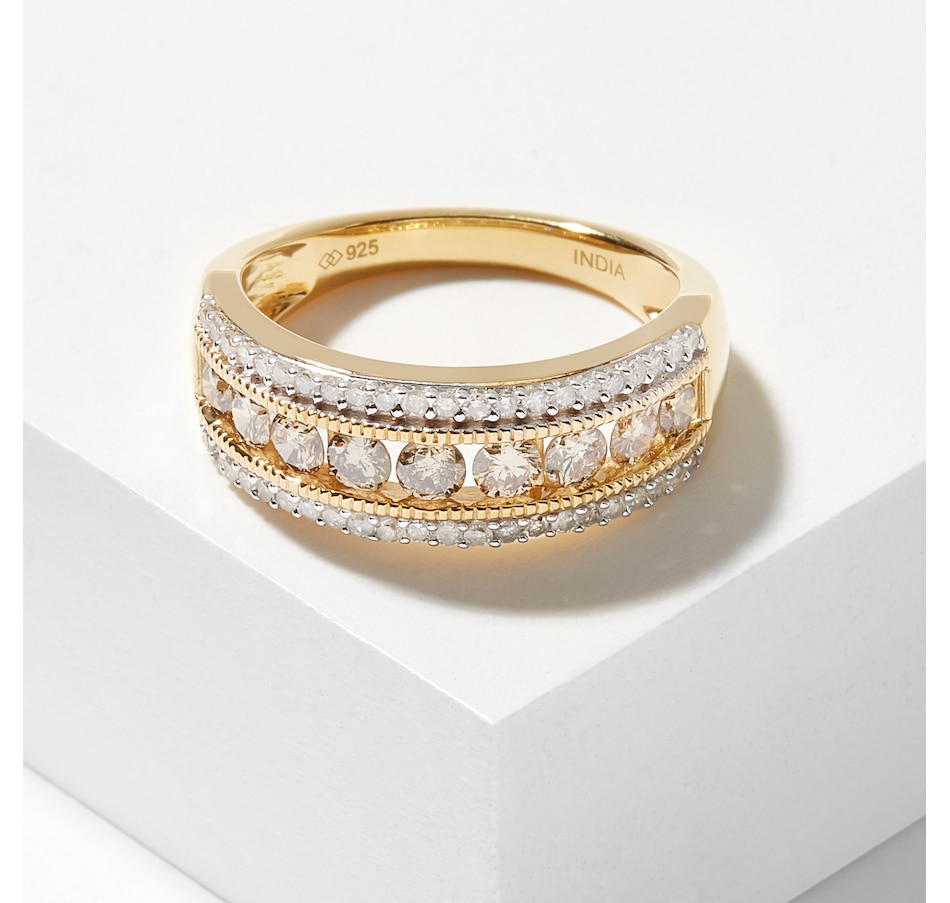Sterling Silver 14K Yellow Gold Plate 1.00 ctw Champagne & White Diamond Ring
Free Shipping
• Sterling silver; 14K yellow gold and rhodium vermeil plating
• (9) round shape, prong set and faceted champagne diamonds- 0.77 av. ctw
• (44) round shape, prong set and faceted white diamonds- 0.23 av. ctw
• Clarity I1-I2; Colour: H; champagne
• Average total carat weight: 1.00 av. ctw
• Average total item gram weight: 3.15g (based on size 7)
• Ring measures approximately 1/4" wide; knuckle to knuckle
• Nickel free
• Made in India
The Four Cs of Diamonds
There are four main factors that affect the value of a diamond, commonly referred to as “the 4 Cs.” The cut, colour, clarity and carat weight all contribute to the rarity, and therefore price, of a diamond.
CUT:
The cut is a diamond's most important characteristic. The way a diamond is cut affects how it handles light and has great influence on the diamond's overall sparkle. The closer to ideal proportions that a diamond is cut, the more light will reflect back to the eye, resulting in the fire and brilliance that make diamonds so beautiful and so popular. Shallow or deep cuts allow light to seep out of the bottom or escape out of the side.

COLOUR:
Diamonds with absolutely no colour are extremely rare. Colour actually refers to a diamond's lack of colour with D being perfectly colourless. The subtle differences in colour among most gem-quality diamonds are due to traces of other elements that were present during the diamond’s formation millions of years ago. Diamonds are rated on a letter scale indicating the degree of yellowish tinge from D all the way to Z, which is markedly yellowy. E and F are colourless to the naked eye, and G, H and I will appear very nearly colourless, particularly in a gold setting. After cut, colour is generally considered the second most important characteristic when selecting a diamond.

While the fire of perfectly colourless diamonds will never go out of style, modern jewellers and jewellery lovers have discovered the incredible beauty of coloured diamonds in gorgeous shades of blue, green, pink, chocolate and even black, and may people prize yellow (or "canary") diamonds for their luminous colour.
CLARITY:
Diamonds usually contain "inclusions", which are small markers of how the diamond formed deep within the earth. Very few diamonds are without inclusions, and such stones are termed "flawless." Inclusions do not necessarily affect beauty, but they do affect value. Many imperfections are microscopic and those with the least and smallest imperfections receive the highest clarity grades.

Diamond Clarity
| FL, IF | Flawless, Internally Flawless: No internal or external inclusions visible under 10X magnification to a trained eye. The most expensive grade. Very rare. |
| VVS1, VVS2 | Very, Very Slightly Included: Inclusions visible only to a trained eye under 10X magnification. Excellent quality. |
| VS1, VS2 | Very Slightly Included: Small inclusions visible with 10X magnification. Not typically visible to the unaided eye. |
| SI1, SI2 | Slightly Included: Varying degrees of small inclusions visible with 10X magnification. A good value. |
| I1, I2, I3 | Included: Flaws may be visible to the naked eye in larger stones. |
CARAT WEIGHT:
Carat weight is the term that people are most familiar with. Carat is a measure of the diamond's weight and may not reflect its size. To understand its size, you need to consider the distance across the top of the diamond measured in millimetres and the cut grade. One carat equals 1/5 of a gram, or 1/142 of an ounce. Each carat is divided into 100 points, so a 3/4 carat diamond can also be said to weigh 75 points or .75 carat. As the weight increases, the rarity increases dramatically…and so does its value.




